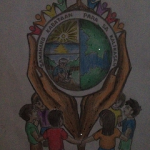 A refreshing wind is running over the little village of Mapanas in Northern Samar. It is 38 degrees and impossible not to feel the sticky skin under your clothes. Everywhere you see people putting a cloth to their heads, trying to wipe away the sweat.
A refreshing wind is running over the little village of Mapanas in Northern Samar. It is 38 degrees and impossible not to feel the sticky skin under your clothes. Everywhere you see people putting a cloth to their heads, trying to wipe away the sweat.
But in the elementary school, just about fifty children are gathered, not concentrating on the heat. They are excited, a little shy, but have a curiosity that is going to save lives — for they are participating in the “Youth Art Workshop for A Culture of Safety”. The children have chosen variant types of art. In one room, we find 15 children sitting and listening. They are being taught how music can be used as a tool for teaching people, and how to behave during an earthquake. In the second room we find another group of children. They are using their creative talent by making puppets that are going to be used for a puppet show. In a whole other area, you would find other children painting the different phases of a typhoon. All of these different groups receive training in how to tell a message through the different types of art.
So what is this culture of safety actually? As an employee from Citizens’ Disaster Response Center (CDRC), said: “The Philippines is like a supermarket, when it comes to disaster. What do you feel like today? An earthquake? A typhoon, maybe? Or we will just do with a fire?” The Philippines is extremely prone to disasters especially in the area where the workshop is being held. Here they have experienced not less than four typhoons in one year. One year!
It is therefore of importance that the community is always ready and aware of the different signs for the various hazards. But how do you make a community, which is so poor and far behind in technology, resistant to hazards? Most of these disasters are natural and we cannot control them. But what the citizens can do is to act quick and according to the kind of disaster.
Through their child-centered disaster risk reduction and management project, CDRC and UNICEF are trying to create the best chances for the community’s lives and livelihood. A part of this project is the art workshop for children. Because children are the future of every country, by making the children observant and informed, the future looks brighter.
CDRC and UNICEF want to address the project to the most vulnerable. Mapanas is hit by typhoons regularly and has not fully recovered from Typhoon Glenda (international name Rammasun) which ruined a lot of livelihoods of the citizens. If you walk around the town, you will still see the ruins from former disasters. Knowing that other hazards that are likely to occur, it is therefore important for the population to be prepared so they can learn how to respond and recover.
Jumping to the final day of the workshop, the participants held a mini concert with the help of the trainers and staff. Everyone in the community was invited. Through song, dance, puppet show, paintings, teaching and fun, the participants showcased the outputs of the workshop to at least 400 community members. This way, not only the participants in the workshop are being educated, but they are also bringing this knowledge further.
The puppet show was a great success. Around 80% of the audience was children who didn’t participate in the workshop. You could see how the stories captured the small figures, as they leant closer to not miss a single word.
The story of puppets tells two different stories. The first is about a family who is not prepared for the typhoon and who didn’t listen to the children when they tried to tell the adults what is about to happen. The family tries to reach the evacuation center, while the typhoon is at its strongest. We see cars and trees flying in the air, and the music creates a dramatic effect. The family does not make it.
The second story describes what to do in preparation for a typhoon. We see a family who listens to their children when they are told about a coming typhoon, and acts on it. This family arrives safely and has a place to stay while the storm is raging.
The conclusion of the stories is hard to miss: Prepare for disaster for your family’s safety. Aside from the evacuation center, the viewers also learn about other things you can prepare for: what to pack in a “Go-Bag” which should be on hand when a hazard is coming.
The second goal for the puppet show is to stress the importance of the voice of children.
The music team performs a song where they have written the lyrics themselves. “Bata, Maghanda” (“Child, Prepare”) as the song is called, has the same message as the puppet show: that children play a big role in preparing for a disaster. If the children are aware at an early age, they will carry this on throughout their adult life. Pass this on to every generation, and we have a community that can act and save lives. We have a culture of safety.
*Rachel Jorgensen is a 23-year old student taking up a Bachelor’s Degree in Emergency and Risk Management at the Metropolitan University College in Copenhagen, Denmark. She is currently taking her internship in international practice at the Citizens’ Disaster Response Center.

Leave a Reply